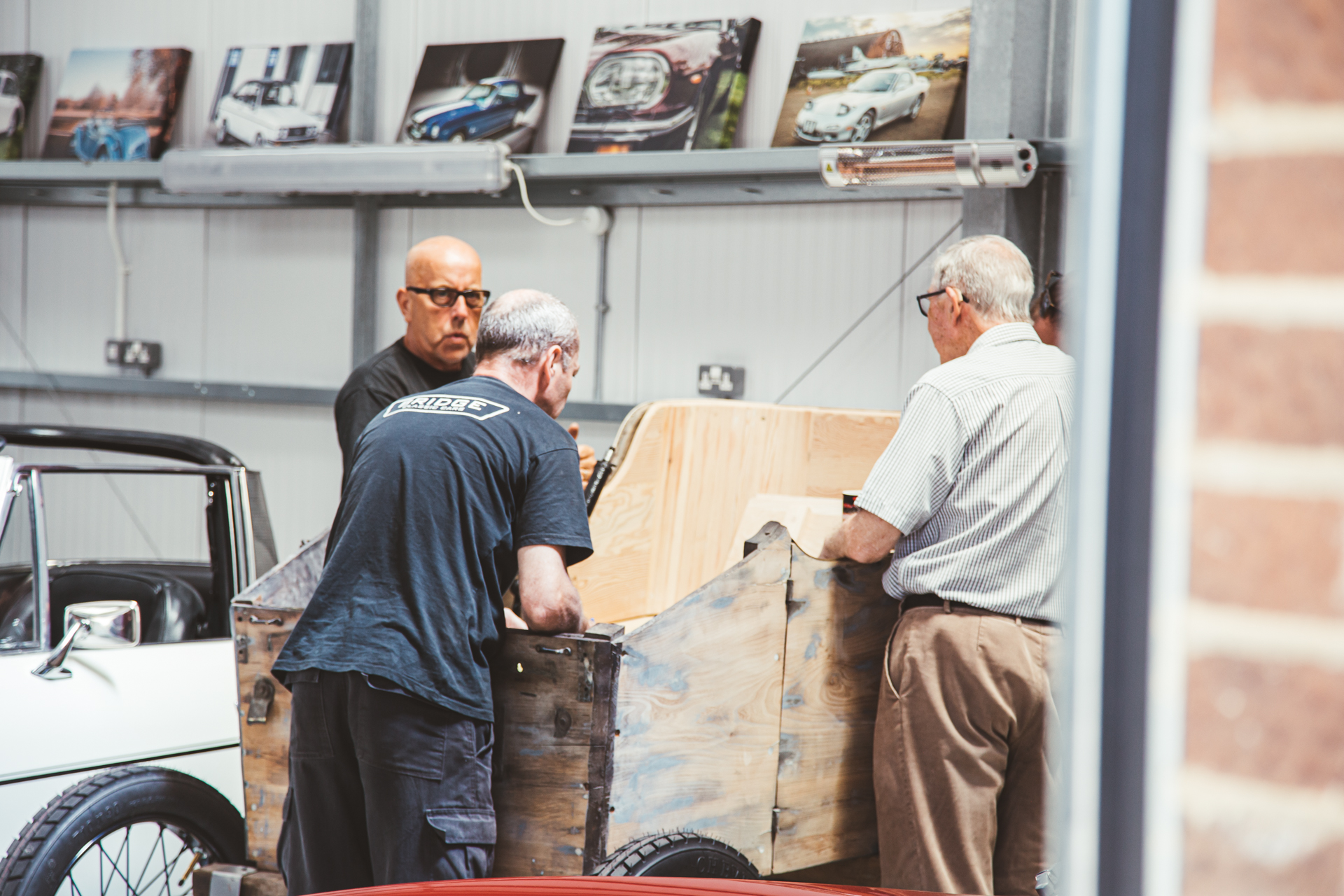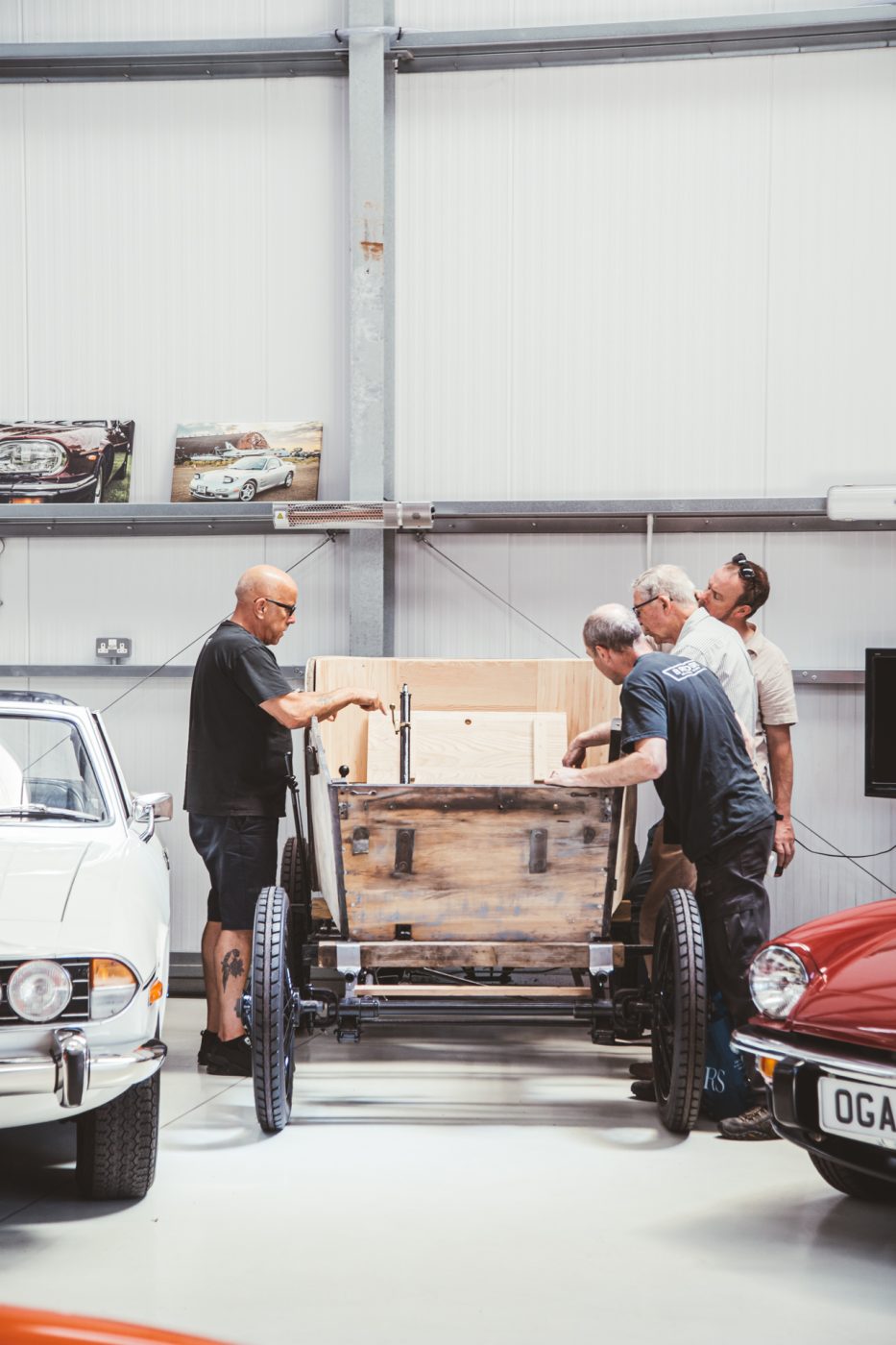Following our recent visit from Geoff Haviland, of the Riley Cars Archive Heritage Trust, he has written us a detailed letter explaining what he believes to be another part of our 1905 Riley 9HP’s story. There is a lot of information within his letter and all of it will likely be useful as we continue to restore this extremely rare vehicle.
Geoff’s letter also contained some images and can be read below:



The 9hp V-Twin Riley CW151
A visit to Bridge Classic Cars in June 2023 enabled me to see this most interesting car. It had been described as a 1905 model and I was very keen to see whether there were differences between it and the two surviving 1907 cars.
A Few Historical Details
At the age of 22 Percy Riley (1880 – 1941) started his own engine company supplying single-cylinder engines to Riley Cycle Co. Ltd for mounting on bicycles and then VTwin versions on Tricars. Engine performance was beginning to outstrip the efficiency of the pneumatic tyres of the period and a burst in the rear wheel of a Tricar at best took two men three hours or more to repair and at worst caused the vehicle to flip over! The answer was to design a car with a wheel on each corner!
Tricars were very popular and continued to be built but were now featuring transverse mounted engines in V-Twin form the first of these appearing in 1905. When the first four-wheeled car appeared it was fitted with the same engine as the 1906 9hp Tricar, two 4 1/2 hp units on a common crankshaft. It is not possible to say exactly when the four-wheeled Riley car was first designed but it was to meet a growing demand for side-by-side motoring and to improve on safety. Riley’s first model was offered to the
public at the Motor Show in October 1906 and was announced as the 1907 Season model but prototypes would have been developed and tested during 1906. Were prototypes built as early as 1905? Looking at the development of the Tricars and the 9hp V-Twin engine this would seem too early but experimental chassis and mock-up body designs may well have been. Riley’s normal practice was to vigorously test out a new chassis in order to eliminate any faults with suspension, steerage, transmission and braking etc. At this stage, the body style was not important and a final approved design would still have been in the future. Successful testing of the chassis would then have led to prototype bodies being mounted on the chassis for further testing, including visual approval. These prototypes would have been much closer to the final design and once any tweaking had been completed the whole design would have been
put forward for approval and production.
Around this time the Stepney wheel appeared. Invented and patented in 1904 this was a ‘get you home’ spare wheel rim without spokes but fitted with an oversize tyre. The rim was clamped to the car wheel and provided a temporary means of getting to somewhere that a flat tyre could be repaired. It fulfilled a need and became so popular that a factory to make them was set up in 1906. Percy Riley regarded them as ‘not an engineering job’ and set out to design a better detachable wheel system. This would have been in 1906 and early efforts would have been trialled on the prototype 9hp cars. By the launch of the car in October 1906 they were only offered as optional extras but became standard fittings in 1907.
No record exists of when Percy’s detachable wheel first saw the light of day but 1905 would again seem rather too early. He may have been working on the system before the Stepney wheel was in full production but family records suggest that he was prompted to design the system on the Stepney becoming so popular.

Known Survivors
Currently, there are four known surviving cars and two further ‘kits of parts’. Of the four cars, three are genuine period examples while the fourth is a replica built over the last 30 years by a New Zealander who is now deceased. Unfortunately, this car has been authenticated by the Veteran Car Club of NZ as a 1905 model!
Some doubt exists with chassis numbers as these were stamped onto tubes or cast iron lugs which have deteriorated or been replaced. They cannot be determined in some cases. The NZ car chassis number is clearly fictitious. Engine numbers are more reliable but would have been shared with the Tricars and proper chronological order cannot be determined. Details of the two kits of parts are not yet to hand.
Example 1 Gaydon Motor Museum Reg. YU 4032 Engine No 1112 chassis No. C/105
Example 2 is with Bridge Classic Cars Reg. CW151 Engine No 860 chassis No. 1572
Example 3 is the RCAHT car Reg. 508 WAR Engine No. 1058 chassis No. unknown.
Example 4 is the NZ car Reg BC8512 Engine No 846 Chassis No 740.
Impressions Of CW151

The first thought was that this car is a bit of an ugly duckling yet it has the suggestion of the elegant ‘swan’ that was to be presented to the public as the first four-wheeled Riley. It has the look of a mock-up which has been hastily assembled in order to do a specific job, allow the testing of the new chassis, but there are pointers to features that the designer had in the back of his mind.
The chassis details are all similar to the 1907 car except that extension pieces of tube about 10″ long have been fitted at the front. The only reason for having these extensions would appear to be to support the extra length of a flimsy scuttle carcase. The nearside door measures about half of this extra length with the result that it is too narrow and the carcase panel on which it is hinged is too long! There is a lot of wasted space in front of the foot pedals! The radiator has to sit in front of this carcase and so it is too far forward over the front axle. The whole look is of a very stretched front end. The top of this carcase is shaped to follow the slope of the dash panel which may have been thought desirable at the time but it creates a very closed-in look and is not as attractive as the 1907 design. Also, the top of the door is higher than the arm of the seat which has resulted in rather awkward infill pieces being fixed to the seat. The problem has been resolved in the 1907 car by lowering the height of the door and reverting to a plain horizontal line.
The seat is a one-piece double-width single unit and photographs do exist that show early production cars having this type of seat but by the time the 1907 catalogue was issued a double seat was used.
The rear body carcase does seem to have progressed to the eventual design but on this car, the timbers used are considerably thinner.
All of this suggests that this car is very likely an experimental design produced for the test programme of the first four-wheeled chassis. It certainly has the looks of a mockup body using lightweight components and lacking the attractive lines that were to follow. It quite possibly precedes the prototype or prototypes which would have been more similar to the final design. For this reason, I believe that this car came very early on in the evolution of the 9hp car and very possibly before the end of 1905, however, the feature that doesn’t fit with this position is the use of detachable wheels.
Percy would have been extremely busy at that time with the supply of engines to The Riley Cycle Co. Ltd. and others. The Tricar was still enjoying huge popularity and Percy was about to introduce the 6hp and the 9hp engines. He was also overseeing his younger brother Stanley, still only 17 years old in 1905 but about to produce his own 5hp Tricar. Add to this Percy’s time spent on the design work of the new four-wheel chassis which leaves little time left for designing a detachable wheel system. We don’t know that the idea had even occurred to him at this stage.
The most likely scenario is that CW151 was fitted with the detachable wheels sometime later in its very long lifetime.
All in all a most intriguing motor car that perhaps presents a bit of a dilemma for Bridge Classic Cars. When deciding on the best way to restore the car there would appear to be three options.
Restore it to its original form as an early mock-up. This entails keeping its stretched appearance and its flimsy body construction but will be historically correct. It would also be preferable if detachable wheels are not used in this case as they came late in 1906 and were not standard until 1907.
Restore all the parts as acquired, retaining the detachable wheels which would then need to be described as a later modification.
Construct the body in its final production form of 1906. The attraction here is that a more attractive, sturdy and usable car would result.
My own preference would be option 1 as this car is unique as a ‘moment in time’ in the Riley story. However, the finished restoration would be more suited to museum or display purposes and would need special handling if it is to last another hundred years. Option 2 would also be acceptable but the later wheels would slightly detract from the ‘moment in time’ argument. Whilst I wouldn’t like to see option 3 go ahead I would understand it from a commercial point of view. BCC are spending a great deal of money in restoring the parts to the highest standard and they would naturally expect a good return on this investment. There is little doubt that a good restoration to the specification of the production model would be the more attractive in design and the most reliable in performance and durability and would thus attract greater interest. This would be a pity in my view as there are two other surviving 1907 cars but nothing else quite like this one!
Geoff Haviland
Riley Cars Archive Heritage Trust.
28 June 2023
